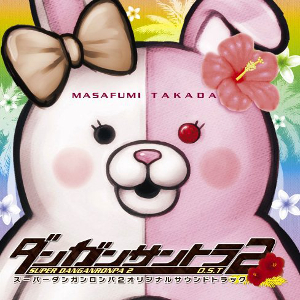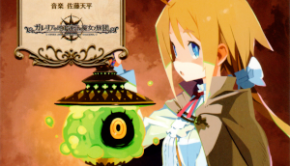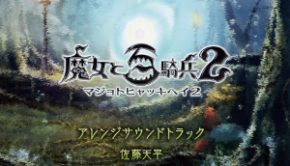Danganronpa 2 -Goodbye Despair- Original Soundtrack
 |
Album Title: Danganronpa 2 -Goodbye Despair- Original Soundtrack (Super Danganronpa 2 Original Soundtrack) |
| Record Label: Sound Prestige Records |
|
| Catalog No.: SPLR-1103/5 |
|
| Release Date: August 31, 2012 |
|
| Purchase: Buy at CDJapan |
Overview
The Danganronpa 2: Goodbye Despair Original Soundtrack will take listeners on a trip from Hell… in the best of ways possible. The Danganronpa 2: Goodbye Despair Original Soundtrack is a substantial collection of expertly mixed and engineered video game music. From action sequences to quirky banter, the music as a stand-alone experience is an eclectic mix to say the least. The diversity of the music is certainly needed to match the mysterious and eccentric feel of the game which takes place on an island resort where a group of high school students are gathered for a game, of sorts. The catch is that the characters cannot leave the island unless a student murders another student, and can get away with it. But does the music truly hold the same production value and hard hitting sound as Takada’s previously released Dangan Ronpa -Trigger Happy Havok- Original Soundtrack? And does this soundtrack live up to the body of work he has already released?
Body
Composer Masafumi Takada work can be easily identified by top-notch production value, diverse genres of music and unique instrumentation. In this album, pulls influences from metal, techno, jazz, latin-fusion, and countless other genres to help make his music diverse and interesting. This soundtrack, and the other Danganronpa soundtracks for that matter, are works for anyone involved in music and audio to study. The mix on this album is loud but tight: bass heavy, but won’t blow your ears apart. Percussion hits are crisp. High-pitched synth parts resonate without feeding back or creating any distortion. Takada brings guitar players Shingo Yasumoto and Jun Fukuda in for some sick guitar leads, and invites vocalists em:ou and Ibuki Mioda to perform on a few tracks.
Take the opening of the soundtrack, “Danganronpa Super Mix”, for example. It is a blend of electronic, modern jazz and rock n’ roll all put together to create an incredibly bombastic intro. Guitar player Yasumoto from Show Design Inc. uses a high gain guitar sound during lead licks and solos. The synth sounds are mixed well with the guitar, but the guitar never over powers the vocal samples or layers of percussion. The solos are tasteful and remain focused around the main riff. I never felt as though Yasumoto got carried away or started taking the music in a different direction.
The soundtrack harkens back to the gloomy hallways of Hope’s Peak Academy while familiar riffs and melodies will haunt players throughout gameplay and during extended cut-scenes. “RE: Despair Syndrome (2)” is similar in nature to “Despair Syndrome” from the first installment of the Danganronpa: Trigger Happy Havoc soundtrack. This selection truly sounds like a haunted mansion, let alone a spooky island resort: the shrill sounding effected voices in the background take a cue right from horror movies and video games; the hip-hop inspired beat that pumps in the background adds a modern characteristic that makes the experience rather surreal; and the electronic sounding percussion instrument that loops in the background has a catchy rhythm and fills plenty of space in between creepy violin swells. “Despair Syndrome (1)” is nearly the same music as “Re: Despair Syndrome 2”, sans the background percussion. I much prefer “Re: Despair Syndrome (2)” over “Re: Despair Syndrome (1)” because the beat keeps me company during the spooky sound effects. These remixes are identical to those featured in Trigger Happy Havok for better or worse.
The other tracks that have been remixed for the Danganronpa 2: Goodbye Despair Soundtrack hold true to production value, instrumentation and attitude from the previous Danganronpa Soundtrack. “Re: Beautiful Morning” is a track that fans of Takada’s work will instantly recognize as a Takada original. The remix has a familiar vibe and iconic harmonies heard in his earlier works. This track especially reminds me of the music Takada wrote for No More Heroes and Killer7, as it contains a similar gritty synth sound and busy, technical percussion. “Re: Buzzkill” has hard hitting percussion and techno inspired synth sounds are mixed in the same style as the previous Ronpa’s “Buzzkill” track. I would have liked to hear a slightly different mix for “Buzzkill”, but the continuity from soundtrack to soundtrack calls for a certain level of familiarity. Unfortunately, this track is one of many that were not selected to be put on the iTunes version.
Not all of these tracks are remixes from Trigger Happy Havoc, however. “Welcome To Dangan Island!” is a quick tempo electronic track that takes influences from techno and other genres of dance music. The catchy synth melody is also heard in “Welcome To Dangan Island! (OP version)”. The only real difference between the two “Welcome” tracks is the sequencer solo in the middle of “Welcome To Dangan Island!”. The differences in the two tracks might go unnoticed for some listeners, but might be interesting for those looking to study the craft of game music as a profession.“Trapped By the Ocean Scent” is an ominous track with metallic sounding instruments carrying the melody. The beat that supports the chaotic and dissonant sounding harmonies adds punch to the rest of the music. Piano and flute can be heard above the layers of electronic instruments, which gives the ear at least a few familiar sounds to hold on to in the sea of synthetic ensembles. The sinister sound continues with the death metal inspired track “From Me To You Too” featuring Ibuki Mioda.
Most of this music could be considered electronic, but still excellent. “Class Trial (Dawn), Vol. 2” is a great example of expertly composed electronic music. The chords are tense while still moving the music forward. The breakbeat-style drums are syncopated and fade in and out in a mysterious way. The percussion never overpowers the melodies, as the glittery sounding synths are clear, floated just above the rest of the mix. “Re: Welcome to Despair” is another prime example of how much attention to detail was put into the engineering and mix. The bells and metallic sounding instruments in the beginning sound like I am hearing the instruments live in a small concert hall. The electronic synth swells add to the mysterious percussion tones, all the while creating an eerie landscape. The music truly dictates the mood during gameplay, looping well during gameplay and never becomes stale when searching for clues or solving a crime.
“Beautiful Dead” and “Beautiful Dasy” from Trigger Happy Havok are also remixed and included on the iTunes version of the DanganRonpa 2 OST. “Beautiful Ruin” and “Beautiful Ruin (Summer Salt)” are expertly envisioned variations of ”Beautiful Dead”. The added percussion in “Beautiful Ruin (Summer Salt)” will take your mind off the fact that students on the resort are being picked off one by one while they remained imprisoned on the Hellhole of an ‘island resort’. I really appreciate the blend of metallic synth sounds and array of hand drums. The music takes on a Jamaican feel that is personified by the ‘steelpan’ instrument that takes the melody. The “Beautiful Days” piano arrangement is a perfect blend of synth and acoustic piano with an acoustic sounding drumset added to the ensemble. This is a much calmer interpretation from Trigger Happy Havoc’s electronic “Beautiful Days”. I prefer the clean sound of the piano as it offers a break from the upbeat, predominantly electronic soundtrack. The laid-back vibe of these tracks maintains a bit of a mystique, but is inviting and groovy enough to put listeners in a good mood.
Note that the physical import version of this soundtrack is the only solid way to pick it up. Fans who purchased the iTunes version of the soundtrack will not be able to listen to the tracks that feature em:ou as the iTunes version only offers selections from the three-disc hard copy version. The theme song “-departure- Short Version” is not included either, which leaves out guest composer, Satoshi Iwase as well as vocalist Megumi Ogata. This is a disappointment for fans and artists alike. Likewise, don’t bother with the bonus soundtrack that came with the NIS America version of the game; in contrast to their Disgaea soundtracks, it is anything but complete, with just eleven tracks and 30 minutes of music.
Summary
People who have never experienced Danganronpa will enjoy the energy put into nearly every track while fans of the series will appreciate the updated mixes. This is a great addition to the growing world of Danganronpa and its library of music that is sure to be considered a masterpiece of a murder mystery visual novel. After careful listening and consideration, this soundtrack does indeed live up to the great quality of Takada’s past work. Just be sure to buy the physical version, as the iTunes version skips out on some of the music of featured artists.
Do you agree with the review and score? Let us know in the comments below!
4
Posted on May 30, 2015 by Marc Chait. Last modified on May 31, 2015.














